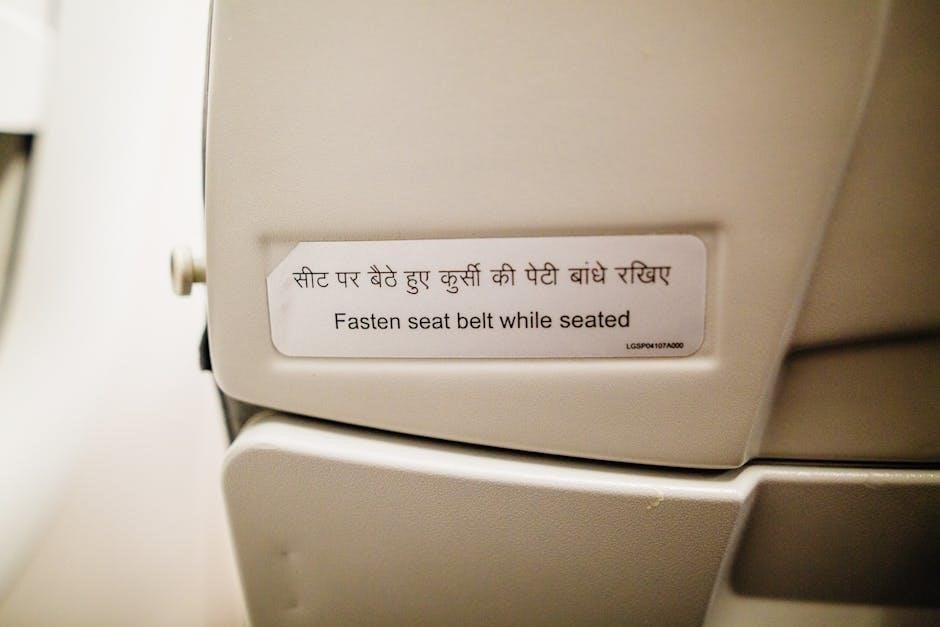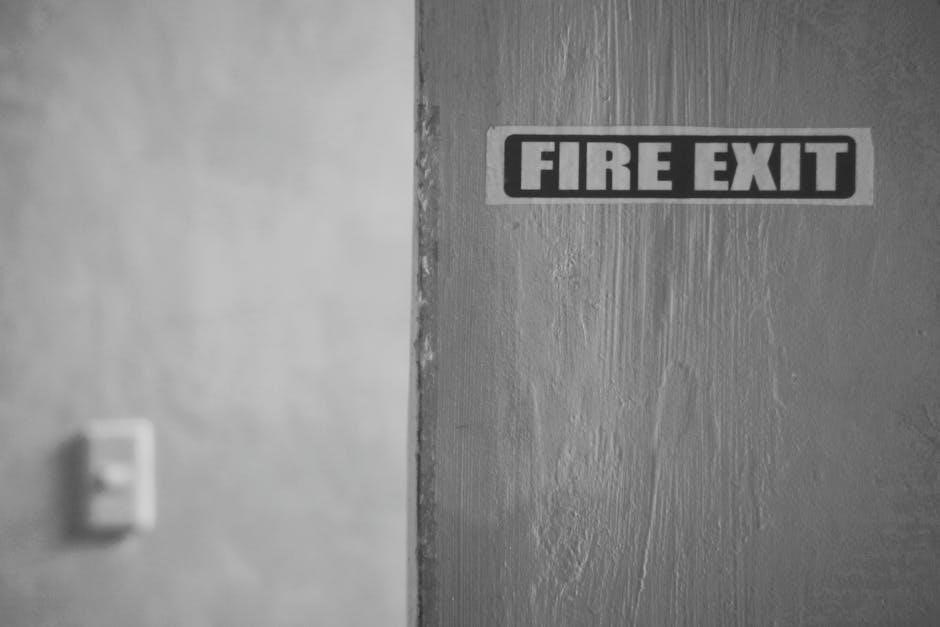Mandatory Instruction Signs: A Comprehensive Guide
Navigating an airport safely requires keen attention to detail. Mandatory instruction signs are essential for pilots, providing critical guidance on the ground. These signs ensure compliance with ATC regulations and prevent runway incursions, and ultimately promote aviation safety. Understanding these is crucial for pilots of all experience levels.
Mandatory instruction signs are integral components of airfield safety, serving as critical communication tools for pilots and ground personnel. These signs provide essential instructions that dictate actions and movements within the airport environment. Mastering these signs is not merely a procedural task; it’s a fundamental skill that directly impacts the safety and efficiency of air operations.
These signs are strategically placed at key locations, such as runway entrances, taxiway intersections, and ILS critical areas, to guide pilots and prevent unauthorized access or movements. Their design, characterized by a red background and white inscriptions, ensures high visibility and immediate recognition. Ignoring or misinterpreting these signs can lead to severe consequences, including runway incursions, near-miss incidents, and potential collisions.
This section will introduce the core concepts surrounding mandatory instruction signs, emphasizing their role in maintaining order and preventing accidents on the airfield. We will explore why these signs are not just regulatory requirements but essential aids for situational awareness. We will also highlight the importance of standardized design, location, and interpretation of these signs in ensuring aviation safety.

Definition and Purpose of Mandatory Instruction Signs
Mandatory instruction signs are defined as visual aids displayed at airports to convey critical instructions to pilots and ground personnel. These signs indicate specific locations or areas where certain actions are required, or where entry is restricted without explicit authorization from Air Traffic Control (ATC). They are characterized by a distinctive design featuring white inscriptions on a red background, ensuring high visibility and immediate recognition in diverse operational conditions.
The primary purpose of mandatory instruction signs is to enhance safety and prevent accidents on the airfield. By clearly delineating areas where aircraft and vehicles must not proceed without clearance, these signs mitigate the risk of runway incursions and other hazardous situations. They provide essential guidance to pilots, ensuring they adhere to ATC instructions and maintain situational awareness throughout their ground operations.
Furthermore, mandatory instruction signs promote operational efficiency by facilitating orderly movement and preventing congestion in critical areas. By clearly marking holding positions, runway entrances, and ILS critical zones, these signs enable pilots to navigate the airfield safely and effectively. They play a crucial role in ensuring compliance with regulatory standards set by aviation authorities, such as the FAA and ICAO, thereby upholding safety protocols.

Importance of Mandatory Instruction Signs in Aviation Safety
Mandatory instruction signs are paramount to aviation safety, serving as essential visual cues that guide pilots and ground personnel within the complex airport environment. These signs are strategically positioned to convey critical information regarding runway access, holding positions, and restricted areas, significantly reducing the risk of ground collisions and runway incursions. Their standardized design, featuring a red background with white inscriptions, ensures immediate recognition, even under low visibility conditions.
The presence of mandatory instruction signs mitigates the potential for pilot error, a major contributor to aviation accidents. By providing clear and concise instructions, these signs help pilots maintain situational awareness and make informed decisions, especially during high-workload phases of flight. They act as a crucial reminder to adhere to ATC clearances and prevent unauthorized entry into active runways or critical areas.
Moreover, mandatory instruction signs are integral to regulatory compliance, ensuring that all airport operations align with established safety standards. Aviation authorities, such as the FAA and ICAO, mandate the use of these signs to promote consistency and interoperability across airports worldwide. Their proper implementation and adherence contribute significantly to the overall safety and efficiency of air travel. In essence, these signs serve as a vital line of defense against potential hazards on the ground.
Types of Mandatory Instruction Signs
Mandatory instruction signs play a crucial role in airport safety, with several distinct types designed to communicate specific instructions to pilots and ground personnel. Each type has a unique purpose and placement, ensuring clear guidance in various operational areas. These signs are essential for preventing runway incursions and maintaining orderly ground traffic flow. Understanding their differences is paramount for all airport users.
One common type is the Runway Holding Position Sign, which marks the boundary between a taxiway and a runway. Pilots must stop at these signs and obtain ATC clearance before proceeding onto the runway. Another type is the ILS Critical Area Holding Position Sign, used to protect sensitive instrument landing system areas from interference. These signs prevent aircraft from disrupting ILS signals during low-visibility approaches.
Additionally, there are Runway Approach Area Holding Position Signs, indicating areas where aircraft must hold short to avoid interfering with approaching or departing aircraft. Taxiway-Runway Intersection Signs are also vital, guiding pilots safely through complex intersections. Each of these signs features a red background with white inscriptions, ensuring high visibility and quick recognition. By familiarizing themselves with these various types, pilots can navigate airports confidently and safely, adhering to all necessary regulations and procedures.
Runway Holding Position Signs
Runway Holding Position Signs are critical components of airport safety, serving as visual cues that dictate where aircraft must stop and await clearance before entering an active runway. These signs are strategically positioned at the intersection of taxiways and runways, clearly marking the boundary beyond which an aircraft cannot proceed without explicit authorization from Air Traffic Control (ATC). Recognizing and adhering to these signs is paramount for preventing runway incursions and ensuring the safe operation of aircraft.
These signs typically feature a red background with white lettering, displaying the runway designation. The visual contrast of the red and white colors ensures high visibility, even in low-light or adverse weather conditions. The runway designation corresponds to the specific runway the sign protects, providing pilots with a clear indication of the potential hazard ahead. When approaching a Runway Holding Position Sign, pilots must bring their aircraft to a complete stop and verify that they have received the necessary clearance from ATC to proceed onto the runway.
Ignoring or misinterpreting these signs can have severe consequences, potentially leading to collisions or near-miss incidents. Therefore, thorough training and a strong understanding of airport signage are essential for all pilots. Runway Holding Position Signs are a fundamental aspect of airport safety infrastructure.
Runway Approach Area Holding Position Signs
Runway Approach Area Holding Position Signs are another crucial type of mandatory instruction sign found at airports. These signs are designed to protect the airspace leading up to a runway, ensuring that no aircraft or vehicle obstructs the approach path of landing aircraft. They are typically located a certain distance from the runway threshold, marking the boundary of the protected area. These signs are essential for maintaining safety during landing operations, especially in instrument meteorological conditions (IMC).
These signs also feature a red background with white inscriptions. The inscription usually indicates the specific runway approach area being protected. For example, it might display something like “RWY 27 APCH,” signaling that the pilot must hold short of the approach area for Runway 27. Pilots encountering these signs must stop and verify they have clearance to proceed, ensuring they do not interfere with aircraft on final approach. Proper adherence to these signs is vital for preventing potential conflicts and maintaining the integrity of the approach airspace.
Runway Approach Area Holding Position Signs contribute significantly to overall airport safety by preventing incursions into critical zones. They play a vital role in safeguarding landing operations and minimizing the risk of accidents.
ILS Critical Area Holding Position Signs
ILS Critical Area Holding Position Signs are essential components of airport safety infrastructure, specifically designed to protect the integrity of Instrument Landing System (ILS) signals. These signs mark the boundaries of areas where aircraft and vehicles must not intrude when the ILS is in use, as any interference can disrupt the signals and compromise the accuracy of approaches. ILS systems provide crucial guidance to aircraft during low-visibility conditions, making the protection of these critical areas paramount for safe landings.

These mandatory instruction signs are identifiable by their red background and white lettering, similar to other mandatory signs on the airfield. They typically display the designation “ILS Critical Area” along with specific runway information, indicating the precise location where holding is required. Pilots and vehicle operators must be particularly vigilant when approaching these signs, especially during periods of low visibility or when ILS approaches are in progress.
Compliance with ILS Critical Area Holding Position Signs is not just a matter of procedure but a critical safety requirement. Failure to hold short of these areas can lead to signal interference, potentially causing inaccurate guidance for approaching aircraft and increasing the risk of accidents. Therefore, pilots and ground personnel must exercise caution and adhere strictly to these signs to ensure the safe and efficient operation of ILS systems.
Taxiway-Runway Intersection Signs
Taxiway-Runway Intersection Signs play a crucial role in maintaining order and preventing incursions at airports. These mandatory instruction signs are strategically positioned at the junctions where taxiways meet runways, guiding pilots and ground vehicles safely through these potentially hazardous areas. Given the high traffic volume and complex movements that often occur at these intersections, clear and unambiguous signage is essential for preventing accidents and ensuring smooth operations.
These signs typically feature a red background with white inscriptions, a standard characteristic of mandatory instruction signs. The inscription usually indicates the runway designation, alerting pilots to the presence of an active runway and the need to obtain clearance before proceeding. In some cases, the sign may also include information about specific restrictions or procedures applicable to that particular intersection.
Pilots must exercise extra vigilance when approaching Taxiway-Runway Intersection Signs, carefully assessing the traffic situation and adhering strictly to ATC instructions. Failure to do so can lead to dangerous runway incursions, where an aircraft inadvertently enters an active runway without authorization. By understanding the purpose and proper interpretation of these signs, pilots can significantly reduce the risk of accidents and contribute to a safer airport environment. Regular review and familiarization with airport diagrams are also crucial for maintaining situational awareness and navigating these intersections effectively.
Reading and Interpreting Mandatory Instruction Signs
The ability to accurately read and interpret mandatory instruction signs is a fundamental skill for all pilots. These signs convey critical information that dictates where an aircraft can and cannot proceed without explicit authorization from Air Traffic Control (ATC). Misinterpreting these signs can lead to serious incidents, including runway incursions and near-miss collisions. Therefore, a thorough understanding of their design, placement, and meaning is paramount for safe and efficient airport operations.

Mandatory instruction signs are designed with a distinctive red background and white inscriptions, a visual cue that immediately alerts pilots to the need for caution. The inscriptions themselves typically consist of letters, numbers, or symbols that convey specific instructions or restrictions. For example, a “Runway Holding Position” sign will display the runway designation (e.g., “18-36”), indicating that pilots must stop and obtain clearance before entering that runway.
Context plays a crucial role in interpreting mandatory instruction signs. Pilots must consider their location on the airfield, the direction of travel, and any relevant ATC instructions. For instance, the meaning of a “No Entry” sign is straightforward, but its implications depend on the specific area it protects. Regular practice and familiarity with airport layouts are essential for developing the ability to quickly and accurately interpret these signs in real-time situations. Additionally, maintaining open communication with ATC and seeking clarification when needed can prevent misunderstandings and ensure safe ground operations.
Key Visual Cues and Contextual Understanding

Mastering mandatory instruction signs goes beyond simply recognizing their shapes and colors; It involves a deep understanding of the visual cues embedded in their design and the ability to interpret them within the broader context of the airport environment. The most prominent visual cue is the red background, which universally signifies a mandatory action or restriction. This instantly alerts pilots to the need for heightened awareness and adherence to specific instructions.
The white inscriptions on the red background provide the specific details. These may include runway designations (e.g., “16-34”), category holding positions (e.g., “CAT II”), or simple directives like “NO ENTRY.” Pilots must be able to quickly and accurately decipher these inscriptions, recognizing that they represent critical boundaries or limitations.
However, visual cues alone are not enough. Contextual understanding is equally vital. Pilots must consider their position on the airfield, the direction of travel, and any communications with Air Traffic Control (ATC). For example, a runway holding position sign near a taxiway intersection indicates a specific point where the aircraft must stop and await clearance before proceeding onto the runway. Similarly, an ILS critical area holding position sign requires pilots to hold short to avoid interfering with sensitive instrument landing systems. Developing a strong contextual awareness is key to navigating airports safely and efficiently.
Locations of Mandatory Instruction Signs at Airports

Mandatory instruction signs are strategically positioned throughout airports to guide pilots and ensure safe ground operations. Their placement is dictated by critical decision points and potential conflict areas, requiring pilots to be particularly vigilant in these zones. One of the most common locations is at runway entrances, where Runway Holding Position Signs are prominently displayed. These signs mark the boundary between taxiways and active runways, requiring pilots to obtain ATC clearance before crossing.
Taxiway intersections are another key location for mandatory signs. These intersections often involve complex traffic patterns, and signs are used to prevent inadvertent runway incursions or conflicts between taxiing aircraft. Pilots should anticipate encountering signs when approaching any intersection, paying close attention to the specific instructions provided.
ILS critical areas, which protect sensitive instrument landing systems, are also marked with specific holding position signs. These signs are located at designated points to ensure that aircraft do not interfere with the ILS signals, particularly during low-visibility conditions. Finally, “NO ENTRY” signs are placed at areas where aircraft are strictly prohibited from entering, such as construction zones or restricted areas. Recognizing these common locations allows pilots to proactively scan for mandatory instruction signs, enhancing their situational awareness and contributing to safer airport operations.

Case Studies of Incidents Involving Mandatory Instruction Signs
Numerous aviation incidents underscore the critical importance of adhering to mandatory instruction signs. One notable case involved a runway incursion at a major international airport. A pilot, fatigued after a long flight, misread a Runway Holding Position Sign and taxied onto an active runway without ATC clearance. This resulted in a near-miss with a departing aircraft, highlighting the potential for severe consequences when signs are ignored.
Another incident occurred during low-visibility conditions. A pilot unfamiliar with the airport layout failed to recognize an ILS Critical Area Holding Position Sign. The aircraft strayed into the protected zone, disrupting the ILS signal and potentially endangering landing aircraft. This case emphasized the need for thorough pre-flight planning and awareness of airport-specific procedures.
A third example involved a miscommunication between a pilot and air traffic control. The pilot, believing they had clearance, proceeded past a Taxiway-Runway Intersection Sign. However, ATC had instructed them to hold short. This misinterpretation led to a runway incursion and a temporary shutdown of airport operations. These case studies demonstrate that even experienced pilots can make mistakes, and a clear understanding of mandatory instruction signs is paramount for preventing accidents and ensuring aviation safety. Consistent training and adherence to standard operating procedures are essential to mitigate these risks.
Best Practices for Pilots to Navigate Signs Safely

Navigating airport taxiways safely demands strict adherence to best practices concerning mandatory instruction signs. Prior to taxiing, pilots should thoroughly review the airport diagram, familiarizing themselves with the location of all mandatory signs along their planned route. During taxi, maintaining a slow and deliberate pace allows ample time to observe and correctly interpret signs.

Pilots must double-check ATC clearances against the indications of mandatory signs. If any discrepancy arises, clarification from ATC is essential before proceeding. When approaching a runway holding position, a complete stop is required, regardless of perceived urgency. Scan the area for other aircraft or vehicles before requesting clearance to cross or enter the runway.
In low-visibility conditions, extra vigilance is crucial. Reduce taxi speed further and utilize all available resources, including radar and enhanced vision systems, to aid in sign identification. Confirm sign recognition with a fellow crew member, if available, to minimize errors; Always prioritize safety over expediency. By integrating these practices into their standard operating procedures, pilots can greatly enhance their ability to navigate mandatory instruction signs safely, contributing to a safer overall aviation environment. Regular review and recurrent training on airport signage are also essential.
